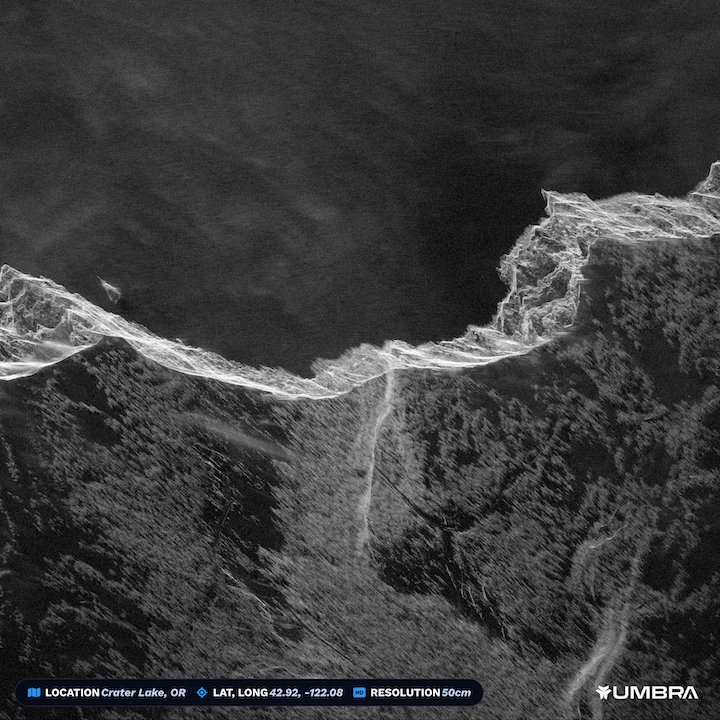DARPA Awards 4 Contracts for SAR Collection and Processing Under the Drift Program

An Umbra SAR image of Crater Lake, Oregon. Photo: Umbra
The Defense Advanced Research Projects Agency (DARPA) has awarded four contracts aimed at flying synthetic aperture radar (SAR) satellites in formation to demonstrate novel imagery collection techniques and enable the development of new algorithms to process the radar data from multiple satellites.
The awards to Umbra, Terran Orbital’s PredaSAR unit, Northrop Grumman and Jacobs were made in late 2022 and early 2023 under the Distributed Radar Image Formation Technology (DRIFT) program, which DARPA says is a key part of its Mosaic Warfare vision to overwhelm enemies with a large number of weapon and sensor platforms.
Umbra and PredaSAR have been funded under other transaction agreements potentially worth $4.5 million and $500,000, respectively, in government funding under Technical Area 1, which is entitled “Formation Flying and Data Collection.” Umbra and PredaSAR make SAR Earth observation satellites.
The DRIFT program was established to take advantage of developments in SAR satellites that have been driven by commercial companies and “offer new opportunities to experiment with novel SAR-related concepts,” DARPA said.
Umbra on Monday said it will fly at least two of its satellites in formation to demonstrate joint image collection techniques “to create synchronized monostatic and bistatic data in support of program objectives.” Monostatic operations refer to one satellite transmitting and receiving its own radar signal while bistatic operations are when one satellite transmits a radar signal and another spacecraft receives the signal and vice versa.
“Collecting from two platforms simultaneously allows for collection of a wider range of radar returns across two vehicles, which can improve detection of objects that could be missed in a monostatic collection due to the geometry of the scene being imaged,” Todd Master, Umbra’s chief operating officer, told Defense Daily in an email reply to questions about the award. “Basically, you’re imaging the scene from two different vantage points simultaneously and combining the information, yielding better insights for the end users.”
The period of performance under Umbra’s agreement began on April 18 and runs for two years.
Terran Orbital last Thursday said the conceptual design work is expected to take several months and may lead to prototypes and demonstrations.
Northrop Grumman and Jacobs received contracts worth up to $3.9 million and $4 million, respectively, under Technical Area 2, which calls for the development of processing algorithms that use the data from the satellites operated by Umbra and PredaSAR in DRIFT. DARPA said the algorithms are aimed at achieving classified objectives. The agency said that it is acquiring the data and algorithms separately using the Compensated Phase History Data format as a “sensor-independent standard to enable interoperability.”
DARPA said that in the base period of the algorithm development, the companies will develop the algorithms and software and also generate simulated radar data that will be used to test their algorithms. Northrop Grumman began work on Jan. 24 and has until March 15 to complete phase 1. Jacobs began on Feb. 2 and its phase 1 runs until April 2.
If one-year phase 2 options are awarded, the satellite providers will collect on-orbit data that will be provided to the algorithm developers. A potential one-year phase 3 for the algorithm developers would be to optimize their products “to run on tactically relevant timescales,” DARPA said.
This article was first published by Via Satellite sister publication Defense Daily.